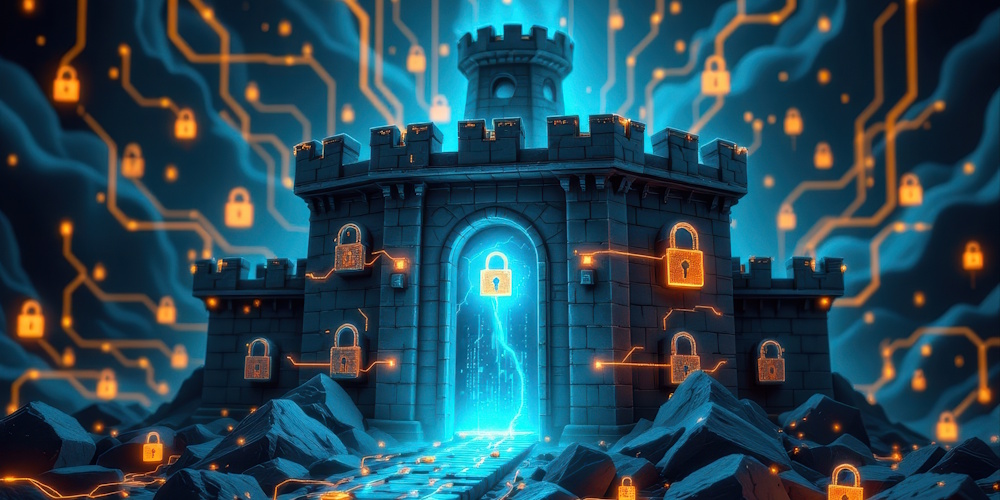Recent Posts
Categories
Stay Informed

If you’re relying solely on a firewall and antivirus software to protect your business, you’re essentially leaving your front door wide open while only locking the bedroom. This traditional approach to cybersecurity worked when threats were simpler, but today’s sophisticated cybercriminals and the use of AI have evolved far beyond what single-layer protection can handle.
The harsh reality? Most successful cyber-attacks begin with a phishing email that bypasses your firewall entirely. Meanwhile, zero-day threat attacks that exploit previously unknown vulnerabilities—are increasing every year. Your current security setup might stop script kiddies, but it’s likely defenseless against the professional cybercriminal organizations targeting businesses just like yours.
After nearly three decades of protecting businesses from evolving cyber threats, ISOCNET has witnessed firsthand how the cybersecurity landscape has transformed. What we’ve learned is that effective business cyber protection requires a fundamentally different approach: cybersecurity defense in depth or layered security. There is no solution that will fully protect your business. You need multiple solutions at every layer of your infrastructure.

Understanding Defense in Depth: Your Digital Fortress Strategy
Think of defense in depth like protecting a medieval castle. You wouldn’t rely on just the outer wall, you’d have multiple barriers: a moat, outer walls, inner walls, guards, and secure chambers. Each layer serves a specific purpose, and if one fails, others continue protecting what matters most.
Cybersecurity defense in depth applies the same principle to your digital assets. It’s a comprehensive security strategy that deploys multiple layers of protection across your entire IT infrastructure, creating redundant safeguards that work together to identify, prevent, and mitigate cyber threats.
The Core Philosophy: No single security tool is perfect. By layering complementary technologies and processes, you create a security ecosystem where the failure of one component doesn’t compromise your entire organization. Think of it as No Single Point of Failure.
This approach is particularly crucial for businesses facing today’s threat landscape, where cybercriminals use sophisticated techniques specifically designed to bypass traditional security measures.

The Modern Threat Landscape: Why Traditional Security Fails
To understand why defense in depth is essential, we need to examine how cyber threats have evolved and why conventional security measures are inadequate.
Phishing Attacks: The Gateway to Disaster
Phishing remains the number one attack vector because it targets the weakest link in any security chain: human psychology. Modern phishing attacks are incredibly sophisticated, targeted, and look just like legitimate communications.
Why Firewalls Can’t Stop Phishing:
- Phishing emails arrive through legitimate email servers
- Malicious links often use trusted domains initially
- Social engineering bypasses technical controls entirely
- Attackers research targets extensively for personalized attacks
- New techniques such as getting undetected malware through a DNS Text file, makes it even harder to detect
- Once a hacker infiltrates your network, it all looks like normal activity.
Real-World Impact: A single successful phishing attack can grant cybercriminals access to your entire network, bypass your firewall from the inside, and remain undetected for months while stealing data or preparing ransomware deployment.
Zero-Day Threats: The Unknown Unknowns
Zero-day threats exploit software vulnerabilities that haven’t been discovered or patched yet. Traditional signature-based antivirus software cannot detect these attacks because no one knows they exist. Hackers are creating new threats every day. Most attacks are no longer signature based.
Why Zero-Day Attacks Are Increasing:
- Software complexity creates more potential vulnerabilities
- Cybercriminal organizations invest heavily in discovering new exploits
- The time between vulnerability discovery and patch deployment creates windows of opportunity
- Many businesses delay applying security patches due to operational concerns
- AI and Ransomware as a Service is making it quicker to deploy new attacks
Business Impact: Zero-day attacks can compromise systems instantly, often providing cybercriminals with administrative access before any security tool recognizes the threat.
Advanced Persistent Threats (APTs)
APTs represent the evolution of cybercrime from opportunistic attacks to targeted, long-term infiltration campaigns. These attacks are designed to establish persistent access to your network while remaining undetected.
APT Characteristics:
- Multi-stage attacks that unfold over months or years
- Use of legitimate system tools to avoid detection
- Lateral movement through networks to access critical data
- Sophisticated command and control infrastructure
Traditional security tools struggle with APTs because they’re designed to detect obvious malicious activity, not subtle, patient infiltration.

The Seven Layers of Effective Cybersecurity Defense in Depth
Implementing comprehensive business cyber protection requires strategic deployment of security measures across seven critical layers. Each layer addresses specific threat vectors while working in concert with others.
Layer 1: Network Perimeter Security
Your network perimeter forms the outer boundary of your digital environment, but modern perimeter security extends far beyond traditional firewalls.
Next-Generation Firewalls (NGFWs):
- Deep packet inspection analyzes data content, not just headers
- Application-aware filtering blocks specific application functions
- Intrusion prevention systems detect and block attack patterns
- Threat intelligence integration provides real-time threat data
Secure Web Gateways:
- Filter web traffic before it reaches your network
- Block access to known malicious websites
- Inspect encrypted traffic for hidden threats
- Provide detailed reporting on web usage and threats
Email Security Gateways:
- Advanced phishing detection using AI and machine learning
- Sandboxing suspicious attachments in isolated environments
- Real-time URL analysis and rewriting
- Business Email Compromise (BEC) Protection
Layer 2: Network Segmentation and Access Control
Network segmentation limits the potential damage from successful attacks by containing threats within specific network segments. Knowing how sophisticated these attacks are, every business must be prepared for when they are attacked. Minimizing exposure is an important security layer.
Micro segmentation Benefits:
- Isolates critical systems from general network traffic
- Prevents lateral movement during security incidents
- Significantly reduces attack surface area
- Enables granular monitoring and control
Zero Trust Network Access:
- Assumes no user or device is inherently trustworthy
- Requires continuous verification for all access requests
- Implements least-privilege access principles
- Monitors all network activity for anomalous behavior
Layer 3: Endpoint Detection and Response (EDR)
Modern endpoint protection goes far beyond traditional antivirus software, providing comprehensive visibility into device activity and behavior. It is constantly looking for inconsistent behavior and can stop a threat before it spreads.
Advanced EDR Capabilities:
- Behavioral analysis detects suspicious activity patterns
- Machine learning identifies previously unknown threats
- Automated threat response and containment
- Forensic capabilities for incident investigation
Endpoint Configuration Management:
- Ensure devices meet security policy requirements
- Automatically patches known vulnerabilities
- Monitors for unauthorized software installations
- Manages encryption and data protection settings
Layer 4: Identity and Access Management (IAM)
Identity-based security recognizes that user credentials are prime targets for cybercriminals and implements robust protection measures.
Multi-Factor Authentication (MFA):
- Requires multiple verification factors for access
- Significantly reduces risk from compromised passwords
- Adapts authentication requirements based on risk assessment
- Integrates with business applications seamlessly
Privileged Access Management (PAM):
- Controls and monitors high-privilege account usage
- Implements just-in-time access for administrative functions
- Records all privileged user activity for audit purposes
- Automatically rotates administrative passwords
Layer 5: Data Protection and Encryption
Protecting data both in transit and at rest ensures that even successful attacks cannot compromise sensitive information.
Data Classification and Loss Prevention:
- Automatically identifies and classifies sensitive data
- Monitors data movement and access patterns
- Prevents unauthorized data transmission
- Provides detailed audit trails for compliance
Encryption Strategies:
- Encrypts data stored on devices and servers
- Protect data transmitted across networks
- Manages encryption keys securely
- Ensures encryption doesn’t impact business operations
Layer 6: Security Monitoring and Analytics
Continuous monitoring provides the visibility necessary to detect threats that bypass other security layers.
Security Information and Event Management (SIEM):
- Aggregates security data from all network sources
- Use correlation rules to identify attack patterns
- Provides real-time alerts for security incidents
- Maintains detailed logs for forensic analysis
User and Entity Behavior Analytics (UEBA):
- Establishes baseline behavior patterns for users and systems
- Detects anomalies that may indicate compromise
- Adapts to changing business patterns automatically
- Reduces false positives through machine learning
Layer 7: Incident Response and Business Continuity
Even with comprehensive prevention measures, some incidents will occur. Effective response capabilities minimize impact and accelerate recovery.
Incident Response Planning:
- Defines clear roles and responsibilities during incidents
- Establish communication protocols for stakeholders
- Includes procedures for evidence preservation
- Regularly tests and updates response procedures
Business Continuity and Disaster Recovery:
- Maintains business operations during security incidents
- Provides alternative access methods for critical systems
- Ensures data backups are protected from ransomware
- Defines recovery time objectives for different scenarios

Implementation Strategy: Building Your Defense in Depth Program
Implementing comprehensive cybersecurity defense in depth requires careful planning, prioritization, and phased deployment. Here’s how to approach this transformation strategically.
Phase 1: Assessment and Foundation
Comprehensive Security Assessment:
- Inventory all digital assets and data flows
- Identify current security tools and their effectiveness
- Assess compliance requirements and regulatory obligations
- Evaluate existing security policies and procedures
Risk Analysis and Prioritization:
- Identify your most critical business assets
- Assess current threat exposure across different attack vectors
- Prioritize improvements based on business impact and likelihood
- Develop risk-based implementation roadmap
Phase 2: Core Infrastructure Hardening
Network Security Enhancements:
- Upgrade firewalls to next-generation capabilities
- Implement network segmentation for critical systems
- Deploy email security gateways with advanced threat protection
- Establish secure remote access solutions
Endpoint Protection Upgrade:
- Replace traditional antivirus with EDR solutions
- Implement device configuration management
- Deploy mobile device management for BYOD environments
- Establish patch management procedures
Phase 3: Advanced Protection Deployment (Months 5-6)
Identity and Access Controls:
- Implement multi-factor authentication across all systems
- Deploy privileged access management solutions
- Establish zero trust access principles
- Integrate identity management with business applications
Data Protection Measures:
- Deploy data loss prevention technologies
- Implement encryption for data at rest and in transit
- Establish data classification and handling procedures
- Create secure backup and recovery systems
Phase 4: Monitoring and Response
Security Operations Center (SOC) Capabilities:
- Implement SIEM platform for centralized monitoring
- Deploy user and entity behavior analytics
- Establish 24/7 security monitoring capabilities
- Create incident response procedures and playbooks
Continuous Improvement:
- Establish regular security assessments and penetration testing
- Implement threat intelligence feeds
- Create security awareness training programs
- Develop metrics for measuring security effectiveness

Managed Security Services: Maximizing Protection While Minimizing Complexity
For many businesses, implementing and managing a comprehensive defense in depth strategy internally is neither cost-effective nor practical. Managed security services provide access to enterprise-level protection with expert oversight. There is a dozen or more products that help provide this level of protection. But experience can go a long way towards managing them effectively and efficiently.
Benefits of Managed Security Services
Access to Expertise:
- Certified security professionals with specialized knowledge
- Continuous training on emerging threats and technologies
- Experience managing security incidents across multiple organizations
- Understanding of compliance requirements across industries
Cost Effectiveness:
- Shared costs across multiple clients reduce individual expenses
- Eliminates need for internal security staff hiring and training
- Reduces capital expenditure on security infrastructure
- Predictable monthly costs for budget planning
- You get a team with a variety of skill sets for the price of 1 person
24/7 Monitoring and Response:
- Round-the-clock security operations center coverage
- Rapid response to security incidents regardless of timing
- Proactive threat hunting to identify hidden threats
- Continuous monitoring of security tool effectiveness
Technology Access:
- Enterprise-grade security tools without full licensing costs
- Regular updates and upgrades managed by service provider
- Integration with existing business systems
- Access to threat intelligence feeds and research

Future-Proofing Your Defense in Depth Strategy
Cybersecurity is constantly evolving, and your defense in depth strategy must adapt to remain effective.
Emerging Threat Considerations
Artificial Intelligence in Cyber Attacks:
- AI-powered Phishing and Social Engineering
- Automated vulnerability discovery and exploitation
- Deepfake technology for fraud and manipulation
- Machine learning evasion techniques
Internet of Things (IoT) Security:
- Exponential growth in connected devices
- Limited security capabilities in many IoT devices
- Network segmentation and access control challenges
- Supply chain security for IoT manufacturers
Technology Evolution for Today’s Threats
Zero Trust Architecture:
- Continued evolution toward zero trust principles
- Integration with cloud services and remote work
- Identity-centric security model adoption
- Continuous verification and validation
Cloud Security Maturation:
- Shared responsibility model understanding
- Multi-cloud security orchestration
- Cloud-native security tool adoption
- Compliance in cloud environments

Taking Action: Your Next Steps
Implementing effective cybersecurity defense in depth doesn’t happen overnight, but every day you delay increases your risk exposure. Here’s how to begin your journey toward comprehensive business cyber protection.
Immediate Actions (Conduct a Basic Security Assessment: Inventory your current security tools and identify obvious gaps)
- Review Cyber Insurance Coverage: Understand what’s covered and what security requirements exist
- Test Your Backup Systems: Ensure you can recover critical data if needed
- Update Employee Training: Refresh phishing awareness and incident reporting procedures
Short-Term Priorities
- Implement Multi-Factor Authentication: Start with critical systems and expand coverage
- Assess Network Segmentation: Identify opportunities to isolate critical systems
- Review Access Controls: Remove unnecessary user access and privileged accounts
- Establish Incident Response Procedures: Define roles and communication protocols
Long-Term Strategy
- Develop Comprehensive Security Roadmap: Plan your defense in depth implementation
- Evaluate Managed Security Services: Consider partnering with security experts
- Establish Security Metrics: Define how you’ll measure security effectiveness
Plan Budget and Resource Allocation: Ensure adequate investment in security initiatives
Partner with ISOCNET for Advanced Security Services
Building and maintaining a comprehensive cybersecurity defense in depth program requires specialized expertise, significant technology investment, and ongoing management attention. For many businesses, partnering with experienced security professionals provides the most effective and cost-efficient approach.
ISOCNET’s Advanced Security Services provide the layered protection your business needs to defend against modern cyber threats. Our defense in depth approach includes multiple layers of protection across your network, from employee training to advanced threat detection and response.
Why Choose ISOCNET:
- 29 + years of experience protecting businesses from cyber threats
- Certified security professionals with ongoing training
- Proven track record with businesses across industries
- Local Cincinnati expertise with nationwide service capability
Ready to Strengthen Your Cybersecurity Posture?
Don’t wait for a security incident to reveal the gaps in your current protection. Contact ISOCNET today for a comprehensive security assessment and learn how our Advanced Security Services can protect your business with proven defense in depth strategies.
Your business depends on reliable, secure technology. Let us help you build the comprehensive protection you need to operate with confidence in today’s threat landscape.
ISOCNET has been providing IT services since 1996, including comprehensive cybersecurity solutions, managed IT services, and digital transformation support for businesses nationwide. Our Advanced Security Services implement proven defense-in-depth strategies that protect against today’s sophisticated cyber threats.



